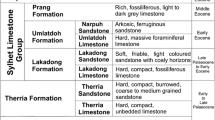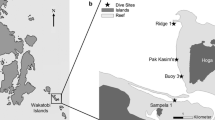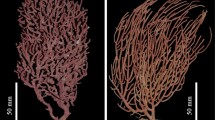Abstract
The diversity of calcareous epiliths along a bathymetrical transect spanning the intertidal to bathyal (0–500 m) was investigated during a two-year carbonate cycling experiment deployed in the Faial Channel, Azores. The epilith inventory comprises 47 taxa of bryozoans, 9 serpulids, 3 bivalves, 3 cirripeds, 3 foraminiferans, 2 vermetid gastropods, and 1 scleractinian coral, along with 6 rhodophyte morphotypes. Colonised surface area, carbonate accretion rates, and biodiversity peak in the deeper euphotic zone (15 and 60 m), where mature biocoenoses were established after 2 years exposure, whereas colonisation was retarded at dysphotic and aphotic depths. Particularly in the photic zone, colonised surface area, accretion rates, as well as species richness and abundance were higher on down-facing compared to up-facing surfaces. Analyses of similarity (ANOSIM) and non-metrical multidimensional scaling (NMDS) of species abundance data revealed that water depth and substrate orientation were the dominant factors controlling the community structure as a result of direct (photosynthesis) and indirect (bioerosion pressure; nutrient supply) effects of the light regime, while exposure time and substrate type had little influence. The same hierarchy applies for the ichnodiversity of bioerosion traces, but with an inverse pattern in case of substrate orientation, reflecting the interaction of encrustation and bioerosion. Positive net carbonate production rates support the development of oyster bioherms and heterozoan-dominated carbonate/volcaniclastic sediments accumulating in the Faial Channel and adjacent slope. A comparison with biogenic sediments from other Macaronesian archipelagos and seamounts demonstrates the abundance and diversity of non-tropical heterozoan carbonates in oceanic islands.









Similar content being viewed by others
References
Ávila SP (2006) Oceanic islands, rafting, geographical range and bathymetry: a neglected relationship? Occup Publ Ir Biogeogr Soc 9:22–39
Ávila SP, Ramalho RS, Habermann J, Quartau R, Kroh A, Meireles R, Berning B, Kirby M, Zanon V, Goss A, Rebelo AC, Melo C, Madeira P, Cordeiro R, Bagaço L, da Silva CM, Cachão M, Madeira J (subm.) A late Miocene storm-induced shell bed (coquina) from the central North Atlantic: taphonomy, palaeoecology and palaeoenvironmental reconstruction. Palaeogeogr Palaeoclimatol Palaeoecol
Ávila SP, Madeira P, Zazo C, Kroh A, Kirby M, da Silva CM, Cachão M, de Frias Martins AM (2009a) Palaeoecology of the Pleistocene (MIS 5.5) outcrops of Santa Maria Island (Azores) in a complex oceanic tectonic setting. Palaeogeogr Palaeoclimatol Palaeoecol 274:18–31
Ávila SP, da Silva CM, Schiebel R, Cecca F, Backeljau T, de Frias Martins AM (2009b) How did they get here? The biogeography of the marine molluscs of the Azores. Bull Soc Geol Fr 180:295–307
Barnes DKA (2002) Invasions by marine life on plastic debris. Nature 416:808–809
Basso D (1998) Deep rhodolith distribution in the Pontian Islands, Italy: a model for the paleoecology of a temperate sea. Palaeogeogr Palaeoclimatol Palaeoecol 137:173–187
Bishop JDD (1989) Colony form and the exploitation of spatial refuges by encrusting Bryozoa. Biol Rev 64:197–218
Braga-Henriques A, Carreiro-Silva M, Tempera F, Porteiro FM, Jakobsen K, Jakobsen J, Albuquerque M, Santos RS (2012) Carrying behaviour in the deep-sea crab Paromola cuvieri (Northeast Atlantic). Mar Biodivers 42:37–46
Braga-Henriques A, Porteiro FM, Ribeiro PA, de Matos V, Sampaio Í, Ocaña O, Santos RS (2013) Diversity, distribution and spatial structure of the cold-water coral fauna of the Azores (NE Atlantic). Biogeosciences 10:529–590
Brett CE, Parsons-Hubbard KM, Walker SE, Ferguson C, Powell EN, Staff G, Ashton-Alcox KA, Raymond A (2011) Gradients and patterns of sclerobionts on experimentally deployed bivalve shells: synopsis of bathymetric and temporal trends on a decadal time scale. Palaeogeogr Palaeoclimatol Palaeoecol 312:278–304
Budd DA, Perkins RD (1980) Bathymetric zonation and paleoecological significance of microborings in Puerto Rican shelf and slope sediments. J Sed Petrol 50:881–904
Carannante G, Esteban M, Milliman JD, Simone L (1988) Carbonate lithofacies as paleolatitude indicators: problems and limitations. Sed Geol 60:333–346
Cardigos F, Tempera F, Ávila SP, Goncalves JM, Colaco A, Santos RS (2006) Non-indigenous marine species of the Azores. Helgol Mar Res 60:160–169
Clarke KR, Warwick RM (2001) Changes in marine communities: an approach to statistical analysis and interpretation, 2nd edn. PRIMER-E, Plymouth
Cowie PR (2010) Biofouling patterns with depth. In: Dürr S, Thomason JC (eds) Biofouling. Wiley-Blackwell, Chichester, pp 87–99
Crisp DJ (1974) Factors influencing the settlement of marine invertebrate larvae. In: Grant PT, Mackie AM (eds) Chemoreception in marine organisms. Academic Press, pp 177–265
Davis AR (2009) The role of mineral, living and artificial substrata in the development of subtidal assemblages. In: Wahl M (ed) Marine hard bottom communities: patterns, dynamics, diversity, and change. Ecological Studies 206. Springer, Berlin Heidelberg, pp 19–38
Donovan SK (2002) Island shelves, downslope transport and shell assemblages. Lethaia 35:277
Donovan SK, van Waveren IM, Portell RW (2013) Island slopes and jumbled shell beds. J Geol Soc Lond 170:527–534
Duineveld GCA, Lavaleye MSS, Berghuis EM (2004) Particle flux and food supply to a seamount cold-water coral community (Galicia Bank, NW Spain). Mar Ecol Prog Ser 277:13–23
Field SN, Glassom D, Bythell J (2007) Effects of artificial settlement plate materials and methods of deployment on the sessile epibenthic community development in a tropical environment. Coral Reefs 26:279–289
Glasby TM (2000) Surface composition and orientation interact to affect subtidal epibiota. J Exp Mar Biol Ecol 248:177–190
Golubic S, Perkins RD, Lukas KJ (1975) Boring microorganisms and microborings in carbonate substrates. In: Frey RW (ed) The study of trace fossils. Springer, Berlin Heidelberg, pp 229–259
Gomes-Pereira JN, Tempera F, Ribeiro PA, Porteiro FM (2012) Notes on fauna associated with an opportunistic artificial reef near cold-water corals. Arquipelago 29:11–18
Hammer Ø, Harper DAT, Ryan PD (2001) PAST: Paleontological statistics software package for education and data analysis. Palaeontologia Electronica, 4, 9 pp., http://palaeo-electronica.org/2001_1/past/issue1_01.htm
Hammer Ø, Harper DAT, Ryan PD (2010) PAST – PAleontological STatistics, ver. 2.03. http://folk.uio.no/ohammer/past/
Hammer Ø, Harper DAT (2006) Paleontological data analysis. Blackwell, Oxford
Harris LG, Irons KP (1982) Substrate angle and predation as determinants in fouling community succession. In: Cairns JJ (ed) Artificial substrates. Ann Arbor Science, Michigan, pp 115–174
Hayton S, Nelson CS, Hood SD (1995) A skeletal assemblage classification system for non-tropical carbonate deposits based on New Zealand Cenozoic limestones. Sed Geol 100:123–141
Henrich R, Freiwald A, Betzler C, Bader B, Schäfer P, Samtleben C, Brachert TC, Wehrmann A, Zankl H, Kühlmann DHH (1995) Controls on modern carbonate sedimentation on warm-temperate to arctic coasts, shelves and seamounts in the Northern Hemisphere: implications for fossil counterparts. Facies 32:71–108
James NP (1997) The cool-water carbonate depositional realm. In: James NP, Clarke JAD (eds) Cool-water carbonates. SEPM Special Publication 56, 1–20, Tulsa
Johannesson K (1988) The paradox of Rockall: why is a brooding gastropod (Littorina saxatilis) more widespread than one having a planktonic larval dispersal stage (L. littorea)? Mar Biol 99:507–513
Johnson ME, da Silva CM, Santos A, Baarli BG, Cachão M, Mayoral E, Rebelo A, Ledesma-Vázquez J (2011) Rhodolith transport and immobilization on a volcanically active rocky shore: Middle Miocene at Cabeço das Laranjas on Ilhéu de Cima (Madeira Archipelago, Portugal). Palaeogeogr Palaeoclimatol Palaeoecol 300:113–127
Johnson ME, Baarli BC, Cachão M, da Silva CM, Ledesma Vázquez J, Mayoral EJ, Ramalho RS, Santos A (2012) Rhodoliths, uniformitarianism, and Darwin: Pleistocene and Recent carbonate deposits in the Cape Verde and Canary archipelagos. Palaeogeogr Palaeoclimatol Palaeoecol 329(330):83–100
Jullien J, Calvet L (1903) Bryozoaires provenant des campagnes de l'Hirondelle (1886–1888). Rés Camp Sci Prince de Monaco 23:1–188
Laubier L (1972) Mission 1969 di bathyscaphe "Archimede" aux Acores observations faites au cours des plongees 1 et 2. Centre National por l'Exploration des Oceans, Serie: Resultats des campagnes à la mer 65–71
Marali S, Wisshak M, López Correa M, Freiwald A (2013) Skeletal microstructure and stable isotope signature of three bathyal solitary cold-water corals from the Azores. Palaeogeogr Palaeoclimatol Palaeoecol 373:25–38
Martins HR (1990) A selected bibliography of the marine fauna and flora of the Azores. Arquipélago 8:35–44
Meco J, Scaillet S, Guillou H, Lomoschitz A, Carracedo JC, Ballester J, Betancort J-C, Cilleros A (2007) Evidence for long-term uplift on the Canary Islands from emergent Mio-Pliocene littoral deposits. Global Planet Chang 57:222–234
Meireles RP, Quartau R, Ramalho RS, Rebelo AC, Madeira J, Zanon V, Ávila SP (2013) Depositional processes on oceanic island shelves – evidence from storm-generated Neogene deposits from the mid-North Atlantic. Sedimentology 60:1769–1785
Milliman JD (1976) Miniacina miniacea: modern foraminiferal sands on the outer Moroccan shelf. Sedimentology 23:415–419
Minchin PR (1987) An evaluation of the relative robustness of techniques for ecological ordination. Vegetation 69:89–107
Motomura I (1932) A statistical treatment of associations. Zool Mag 44:379–383
Nelson CS, Hyden FM, Keane SL, Leask WL, Gordon DP (1988a) Application of bryozoan zoarial growth-form studies in facies analysis of non-tropical carbonate deposits in New Zealand. Sed Geol 60:301–322
Nelson CS, Keane SL, Head PS (1988b) Non-tropical carbonate deposits on the modern New Zealand shelf. Sed Geol 60:71–94
Nicoletti L, Marzialetti S, Paganelli D, Ardizzone GD (2007) Long-term changes in a benthic assemblage associated with artificial reefs. Hydrobiologia 580:233–240
Parsons-Hubbard KM, Brett CE, Walker SE (2011) Taphonomic field experiments and the role of the Shelf and Slope Taphonomical Initiative. Palaeogeogr Palaeoclimatol Palaeoecol 312:195–208
Pérès JM (1992) Le bathyscaphe Francais Archimède aux Acores: Étude bionomique et ecologique du benthos profond. Acoreana Suppl 1992:237–264
Piazena H, Perez-Rodrigues E, Häder D-P, Lopez-Figueroa F (2002) Penetration of solar radiation into the water column of the central subtropical Atlantic Ocean – optical properties and possible biological consequences. Deep-Sea Res II 49:3513–3528
Preston FW (1962) The canonical distribution of commonness and rarity. Ecology 43(185–215):410–432
Quartau R, Trenhaile AS, Mitchell NC, Tempera F (2010) Development of volcanic insular shelves: insights from observations and modelling of Faial Island in the Azores Archipelago. Mar Geol 275:66–83
Quartau R, Tempera F, Mitchell NC, Pinheiro LM, Duarte H, Brito PO, Bates R, Monteiro JH (2012) Morphology of the Faial Island shelf (Azores): the interplay between volcanic, erosional, depositional, tectonic and mass-wasting processes. Geochem Geophys Geosyst 13, Q04012. doi:10.1029/2011GC003987
Ramalho R, Quartau R, Trenhaile AS, Mitchell NC, Woodroffe CD, Ávila SP (2013) Coastal evolution in oceanic islands: a complex interplay between volcanism, erosion, sedimentation and biogenic production. Earth Sci Rev 127:140–170
Santos RS, Hawkins S, Monteiro LR, Alves M, Isidro EJ (1995) Marine research, resources, and conservation in the Azores. Aquat Conserv 5:311–354
Santos RS, Tempera F, Colaço A, Cardigos F, Morato T (2010) Spotlight: Dom João de Castro Seamount. Oceanography 23:200–201
Scoffin TP, Alexandersson ET, Bowes GE, Clokie JJ, Farrow GE, Milliman JD (1980) Recent, temperate, sub-photic, carbonate sedimentation: Rockall Bank, northeast Atlantic. J Sed Petrol 50:331–356
Taylor PD, Wilson MA (2002) A new terminology for marine organisms inhabiting hard substrates. Palaios 17:522–525
Tempera F, Giacomello E, Mitchell NC, Campos AS, Braga-Henriques A, Bashmachnikov I, Martins A, Mendonça A, Morato T, Colaço A, Porteiro FM, Catarino D, Gonçalves J, Pinho MR, Isidro IJ, Santos RS, Menezes G (2012) Mapping the Condor seamount seafloor environment and associated biological assemblages (Azores, NE Atlantic). In: Harris PT, Baker EK (eds) Seafloor geomorphology as benthic habitat: Geohab atlas of seafloor geomorphic features and benthic habitats. Elsevier, London, pp 807–818
Thiel M, Gutow L (2005) The ecology of rafting in the marine environment. II. The rafting organisms and community. Oceanogr Mar Biol 43:279–418
Tipper JC (1979) Rarefaction and rarefiction - the use and abuse of a method in paleoecology. Paleobiology 5:423–434
Vogel K, Gektidis M, Golubic S, Kiene WE, Radtke G (2000) Experimental studies on microbial bioerosion at Lee Stocking Island, Bahamas and One Tree Island, Great Barrier Reef, Australia: implications for paleoecological reconstructions. Lethaia 33:190–204
Wahl M (2009) Marine hard bottom communities: patterns, dynamics, diversity, and change. Ecological Studies 206. Springer, Berlin Heidelberg
Westphal H, Halfar J, Freiwald A (2010) Heterozoan carbonates in subtropical to tropical settings in the present and past. Int J Earth Sci 99:153–169
Wisshak M, Gektidis M, Freiwald A, Lundälv T (2005) Bioerosion along a bathymetric gradient in a cold-temperate setting (Kosterfjord, SW Sweden): an experimental study. Facies 51:93–117
Wisshak M, López Correa M, Gofas S, Salas C, Taviani M, Jakobsen J, Freiwald A (2009a) Shell architecture, element composition, and stable isotope signature of the giant deep-sea oyster Neopycnodonte zibrowii sp. n. from the NE Atlantic. Deep-Sea Res I 56:374–404
Wisshak M, Neumann C, Jakobsen J, Freiwald A (2009b) The ‘living-fossil community’ of the cyrtocrinid Cyathidium foresti and the deep-sea oyster Neopycnodonte zibrowii (Azores Archipelago). Palaeogeogr Palaeoclimatol Palaeoecol 271:77–83
Wisshak M, López Correa M, Zibrowius H, Jakobsen J, Freiwald A (2009c) Skeletal reorganisation affects geochemical signals, exemplified in the stylasterid hydrocoral Errina dabneyi (Azores Archipelago). Mar Ecol Prog Ser 397:197–208
Wisshak M, Form A, Jakobsen J, Freiwald A (2010) Temperate carbonate cycling and water mass properties from intertidal to bathyal depths (Azores). Biogeosciences 7:2379–2396
Wisshak M, Tribollet A, Golubic S, Jakobsen J, Freiwald A (2011) Temperate bioerosion: Ichno- and biodiversity from intertidal to bathyal depths (Azores). Geobiology 9:492–520
Young PS (1998) Cirripedia (Crustacea) from the "Campagne Biacores" in the Azores region, including a generic revision of Verrucidae. Zoosystema 20:31–92
Zeff ML, Perkins RD (1979) Microbial alteration of Bahamian deep-sea carbonates. Sedimentology 26:175–201
Zibrowius H (1980) Les Scléractinaires de la Méditerranée et de l'Atlantique nord-orental. Mem Inst Oceanogr Monaco 11:1–227
Zibrowius H, Cairns SD (1992) Revision of the Northeast Atlantic and Mediterranean Stylasteridae (Cnidaria: Hydrozoa). Mem Mus Nat Hist Natl A 153:1–136
Acknowledgments
Carrying out the experiment was only possible with the commitment of the Rebikoff Niggeler Foundation and their submersible ‘LULA’. Taxonomic identifications greatly profited from the expertise of H. Zibrowius (serpulids, scleractinian corals), J.-G. Harmelin (cyclostome bryozoans), J. Aguirre and M. Verlaque (coralline algae), and S. Schiaparelli (vermetid gastropods). I. Pyko helped with the assessment of carbonate accretion densities, and N. Belou supported the statistical analyses (ANOSIM). Sediment samples were taken during RV Victor Hensen cruise VH97, funded by the Deutsche Forschungsgemeinschaft (He 1671/1). The manuscript was improved based on the thorough reviews and valuable comments provided by Sérgio Ávila and anonymous referees. The EU FP7 Synthesys program allowed BB to study bryozoan type material at the Muséum National d'Histoire Naturelle, Paris (FR-TAF-1902). The settlement experiment was financed by the Deutsche Forschungsgemeinschaft (DFG Fr 1134/12).
Author information
Authors and Affiliations
Corresponding author
Rights and permissions
About this article
Cite this article
Wisshak, M., Berning, B., Jakobsen, J. et al. Temperate carbonate production: biodiversity of calcareous epiliths from intertidal to bathyal depths (Azores). Mar Biodiv 45, 87–112 (2015). https://doi.org/10.1007/s12526-014-0231-6
Received:
Revised:
Accepted:
Published:
Issue Date:
DOI: https://doi.org/10.1007/s12526-014-0231-6




